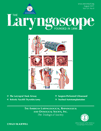Optimal concentration of hepatocyte growth factor for treatment of the aged rat vocal fold†
This research was supported by National Institutes of Health grant R21 DC 009873 from the National Institute of Deafness and Other Communication Disorders. The authors have no other funding, financial relationships, or conflicts of interest to disclose.
Abstract
Objectives/Hypothesis:
Hepatocyte growth factor (HGF) demonstrates beneficial properties in the treatment of aged vocal folds. However, the optimal concentration of HGF remains unknown. The purpose of the present study was to investigate the effects of HGF concentration on treatment of the aged rat vocal fold.
Study Design:
Prospective animal study.
Methods:
Seventy-five rats were studied. The rats were divided into five groups and received serial injections of HGF in 10 μL of phosphate-buffered saline (PBS) at the following concentrations: 10 ng/10 μL, 50 ng/10 μL, 100 ng/10 μL, 200 ng/10 μL, or control (PBS only). Alcian blue staining was performed to investigate hyaluronan (HA), and immunohistochemistry was performed to investigate collagen type I and III. Gene expression of hyaluronic acid synthase (HAS)-1, -2, matrix metalloproteinases (MMP)-2, -9, and procollagen I and III were also investigated using real-time polymerase chain reaction (RT-PCR).
Results:
Histologic analyses revealed increased HA and decreased collagen type I in rats receiving injections of HGF at 100 ng/10 μL. Results were supported by RT-PCR revealing upregulated expression of HAS-2, decreased expression of procollagen I, and a significant increase of MMP-9 mRNA in rats receiving HGF at 100 ng/10 μL.
Conclusions:
We report the first in vivo concentration study of HGF for treatment of the aged vocal fold. Results revealed desirable biochemical effects of HGF at 100 ng/10 μL. These data will be used to provide immediate direction to programmatic efforts aimed at examining future applications of HGF for treatment of the aged vocal fold.




